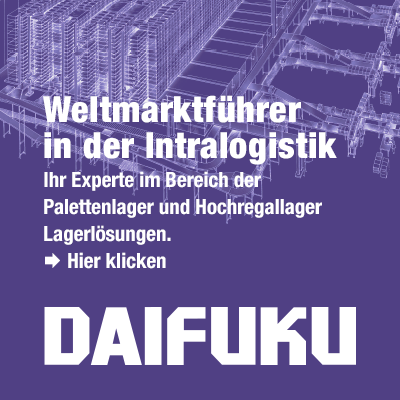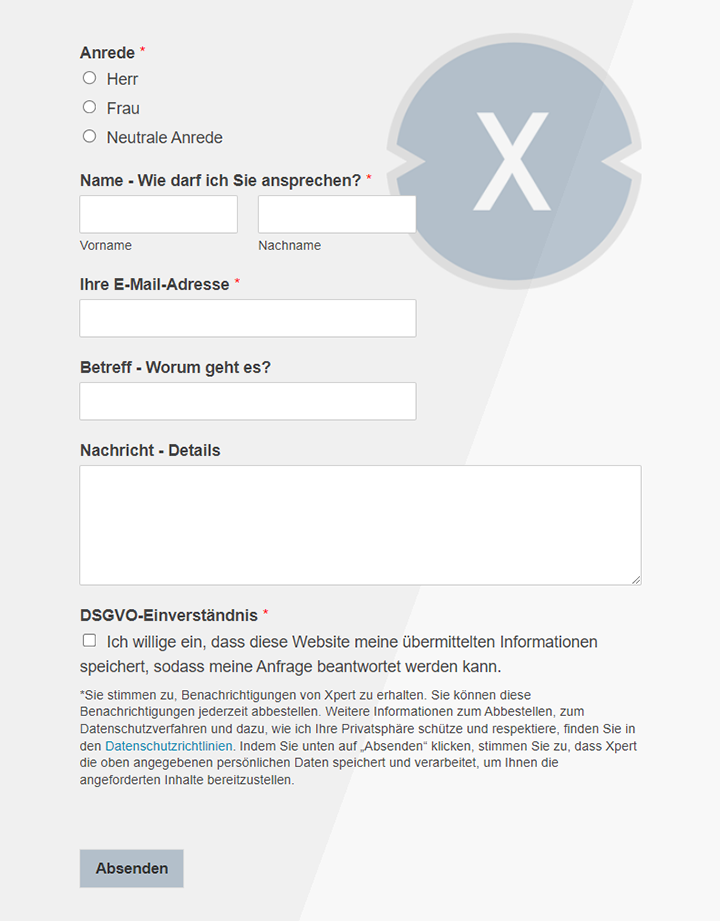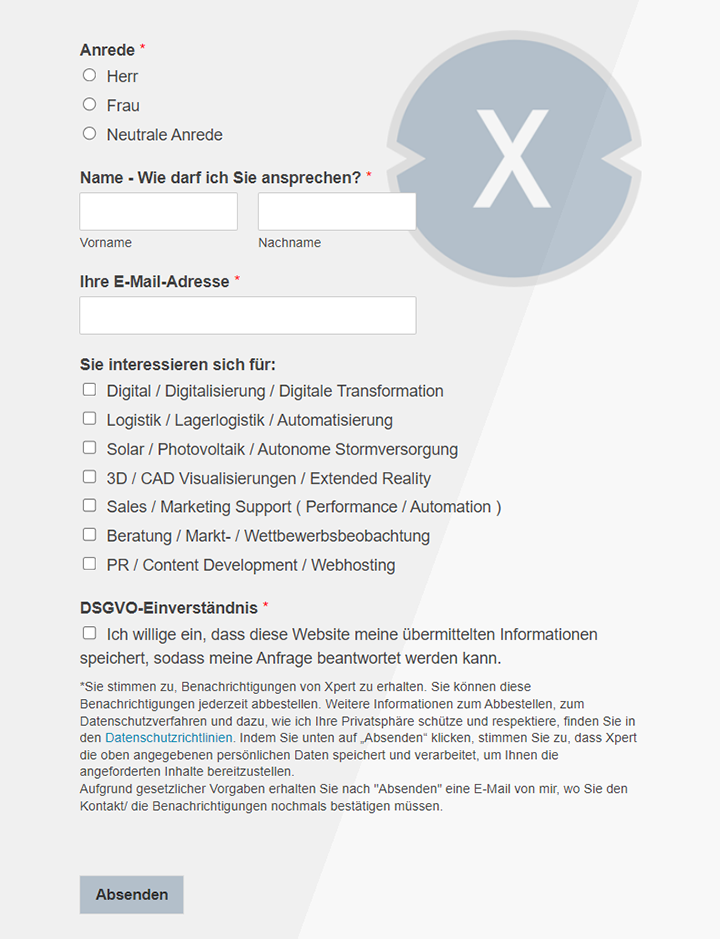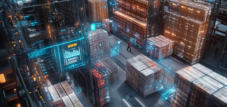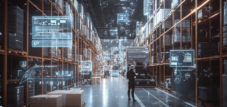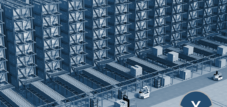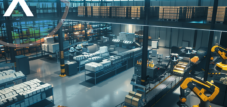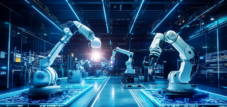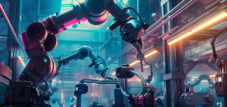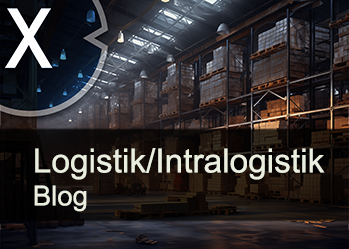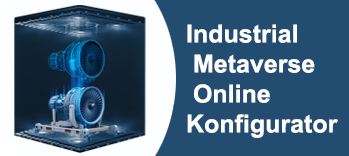The role of AI and robotics in modern warehousing – buffer warehouses as strategic hubs
Xpert pre-release
Language selection 📢
Published on: January 24, 2025 / update from: January 24, 2025 - Author: Konrad Wolfenstein
Strategic hubs: The smart symbiosis of robotics and buffer storage
The role of AI and robotics in modern warehousing
In times of globalized markets, increasingly individual customer requests and increasing demands on delivery speed, AI and robotics have established themselves as important drivers of innovation. Where forklift drivers used to manually transport boxes and pallets from A to B, autonomous mobile robots (AMRs) are now in use that can pick, transport and pack goods around the clock.
This automation works at different levels:
First, robots make it possible to perform repetitive tasks reliably and quickly. Whether it is storing, repacking or picking items – robotic systems carry out these tasks with high precision and without breaks. This can minimize waiting times, reduce error rates and speed up work processes overall.
Secondly, AI algorithms come into play, analyzing huge amounts of data in real time and recognizing patterns. This data-driven intelligence can make predictions, for example about how high the demand for certain products will be and at what times. In this way, inventories can be planned better, buffers can be used more effectively and bottlenecks can be avoided. At the same time, the utilization of the systems is optimized, which leads to greater efficiency and lower costs.
Thirdly, the connection between robotics and AI ensures constant learning. The robots not only act according to rigid specifications, but also adapt their routines based on real-time information. “We have developed an amazing ability to react flexibly to changes” is the statement of many engineers involved in the development of these systems. For example, orders can be prioritized, robot routes can be dynamically adjusted, or additional capacity can be automatically provided in the event of a sudden increase in the volume of goods.
All of these factors merge to form a so-called “intelligent warehousing” in which all processes are coordinated and continuously improved. This leads to a high level of transparency within the warehouse and along the entire supply chain. A central component is the warehouse management system (WMS), which acts as the “brain” of the system. All relevant information comes together here, and based on this data, the AI makes independent decisions or supports human decision-makers.
Buffer warehouses as strategic hubs
Buffer storage originally served primarily to compensate for fluctuations in the supply chain. They were places where goods were either temporarily stored or prepared for further transport. These warehouses have now developed into highly specialized centers in many industries that go far beyond mere buffer storage. “We use our warehouse as an innovation laboratory,” report modern logistics managers who use AI and robotics to conduct experiments before implementing large-scale process changes throughout production or sales.
Buffer storage makes a crucial contribution to regional economic stability because they can prevent bottlenecks and supply interruptions. The value of such camps as a “buffer zone” becomes particularly evident in times of crisis – be it due to natural disasters, pandemics or geopolitical tensions. If supply chains are interrupted elsewhere, a well-managed warehouse can compensate for short-term shortages and thus ensure supply to customers. This has a direct impact on the competitiveness of companies and increases their attractiveness as employers, which also stimulates the regional labor market.
At the same time, modern technologies make it easier to reduce inventories in buffer warehouses without increasing the risk of failures. The AI calculates exactly what quantities are needed and how long certain items need to be in stock. Where large safety stocks were previously kept in stock to cushion possible delivery delays, today a smaller number of units is often sufficient because the system warns of bottlenecks at an early stage. This reduces storage costs and at the same time reduces capital commitment and resource consumption.
Many companies report that they were able to trigger a boost in innovation throughout the entire company through targeted modernization of their buffer warehouses. “New ways of thinking in the warehouse are inspiring our research and development,” is what is often said when managers explain the interactions between production, sales and logistics. Anyone who has recognized the possibilities of automated and AI-controlled processes in the warehouse also transfers these ideas to other areas of the company in order to achieve similar efficiency gains there.
Suitable for:
Key benefits of automation: From efficiency to sustainability
The benefits of widespread automation with AI and robotics can be seen in several dimensions. Traditionally, the focus is on higher efficiency and productivity, as these aspects are often considered crucial in terms of competitiveness. But other points are also increasingly coming into focus.
First, automation leads to a significant reduction in errors. Robots and AI systems not only work according to predefined algorithms, but also continuously monitor and analyze their own processes. If irregularities are detected, they automatically enter correction mode or inform human operators who can intervene. In many industries, accuracy is a critical factor, for example in the pharmaceutical or food industries, where safety and quality are paramount. Here, precise picking ensures high customer satisfaction and minimizes the risk of expensive recalls.
Secondly, costs are reduced because staff are less required to carry out monotonous or physically demanding tasks and the machines can work around the clock. Instead, new, qualified jobs are being created, for example in the areas of AI development, robot maintenance and data analysis. “We have significantly restructured our personnel structure and were able to attract new talent,” explain company representatives, who are specifically investing in training programs and collaborations with universities.
Third, automation allows for better scalability. Especially in times when online business is booming, order peaks can be managed quickly and flexibly without having to completely rebuild the system. The robot fleet in the warehouse can be expanded to include additional units if necessary; The AI algorithms are continuously developed and adapted to new requirements.
Fourth, sustainability is playing an increasingly important role. Environmental awareness and the efficient use of resources are not only social concerns, but also economic factors. Companies that rely on “green logistics” benefit from a positive image and save costs by reducing energy consumption and waste. “Our AI-controlled systems enable us to control the flow of materials much more precisely, which has a positive effect on our carbon footprint,” is the feedback from many logistics managers who highlight the advantages of intelligent warehouse processes.
AI as a driver of process optimization: real-time data and learning systems
The focus of current development is AI-supported data analysis. Modern warehouses are equipped with sensors and IoT devices that enable constant monitoring of the flow of goods, inventory levels and condition systems. These data streams are evaluated in real time so that immediate responses can be made if necessary. “We can prevent problems before they arise,” emphasize technicians responsible for system monitoring.
Based on this amount of data, precise predictions can be made, for example about future fluctuations in demand or maintenance intervals. With the help of predictive analytics, companies can not only plan precisely, but also proactively initiate maintenance measures. For example, if an autonomous robot breaks down due to wear and tear, in the worst case scenario this can delay the entire supply chain. This risk can be reduced to a minimum through predictive maintenance that is planned with the help of AI calculations.
In addition to such preventative approaches, there are AI models that constantly make suggestions for optimization during ongoing operations. For example, when it comes to dynamizing routes for transporting goods in the warehouse: “The planning of our AMRs adapts to the current situation every second,” describe warehouse managers, who thus avoid longer waiting or travel times for robots and increase overall efficiency. This flexibility pays off, especially for items with changing demand, as operations in the warehouse always remain aligned with current needs.
Another important aspect is automated quality control. Using image recognition or scanning systems, robots check incoming items and detect defective goods at an early stage. This saves resources because the faulty parts are not only noticed at the end of the chain and may result in time-consuming and costly rework. “We now record quality defects immediately and can inform our suppliers immediately,” explain companies that use this timely communication to improve their relationships with suppliers and optimize processes together.
Positive effects on regional economies
The integration of AI and robotics into automated buffer warehouses not only has an impact within warehouse logistics itself, but also has far-reaching consequences for the entire regional economy. It has already been shown in many regions that companies that have invested in these technologies at an early stage are more resilient and successful in global competition.
On the one hand, the region's general ability to innovate is growing thanks to the possible uses of AI and robotics. Research collaborations between companies and universities are being intensified, local technology locations are becoming more important and attracting highly qualified specialists. As a result, an “innovation ecosystem” is created that fuels sustainable growth and creates jobs. “We were able to establish our region as a modern technology location,” confirm many economic developers who specifically bring start-ups and established companies together.
On the other hand, not only large, but also small and medium-sized companies (SMEs) benefit from the new possibilities in warehouse automation. For these companies, it is often vital to be able to deliver quickly and reliably in order to keep up with large competitors. With the help of standardized robotics modules and cloud-based AI solutions, SMEs can implement automation that was still associated with high hurdles a few years ago. “We see automation as an opportunity to maintain our quality standards and still grow profitably,” is the assessment of many medium-sized companies that want to use digitalization as a springboard.
In addition, automated buffer warehouses have a direct impact on the supply chain. Shorter delivery times and a more stable supply not only have a positive impact on the end customer, but also on neighboring sectors of the economy such as logistics service providers, suppliers or local craft companies. If more goods are produced or processed in the region, this strengthens the entire value chain and offers new cooperation opportunities for local companies.
Overall, this creates a cycle of positive effects: stable and efficient buffer warehouses ensure a better supply, which in turn increases purchasing power and trust in regional providers. This makes it easier to overcome crises and exploit growth potential that would often remain unused without modern technologies.
New jobs and training needs
A frequently discussed aspect of automation is the possible loss of jobs as robots take over certain tasks. However, practice shows that in addition to replacing repetitive or physically demanding tasks, numerous new job profiles are also emerging. “We need more and more data experts, robotics engineers and AI development specialists,” explain companies that are specifically expanding their human resources departments.
Specialists are needed to program the algorithms, maintain the robots or set up interfaces between different IT systems. The topic of “human-robot collaboration” also requires new skills. Cobots, i.e. collaborative robots, are designed to work side by side with human workers without causing safety risks. However, this requires employees who are familiar with the processes and can program or control the devices.
At the same time, many employees experience an upgrade in their jobs. “We've been relieved of the monotonous hard work and now we're concentrating on control and monitoring,” say warehouse workers who have trained to enable collaboration with robots. Companies support this development by offering retraining and upskilling programs, often in collaboration with local educational institutions. This means that people who previously only had limited digital skills can take part in the new processes.
From an economic perspective, this means that the qualification structure is changing. Regions that invest in the development and expansion of appropriate training offerings at an early stage improve their chances of successfully mastering the transformation. Innovative training projects often arise, for example in the form of demonstration centers, “real-world laboratories” or funded collaborations with universities, in which real use cases can be examined and practically trained.
Robot cost? How companies master the hurdle of expensive infrastructure
Despite all the advantages, various challenges must also be mastered when implementing AI and robotics systems. One of them lies in the high initial investments. Automated storage systems are complex, need an elaborate infrastructure and experienced staff. This can be a considerable financial hurdle for some companies. "Without financial funding, that would hardly be stamped for us," emphasize small and medium -sized companies in particular that do not have the same reserves as large corporations. In many regions, however, special funding programs are created that support companies on their way to digitization.
Another point concerns the legal framework. With the increasing spread of AI and autonomous systems, topics such as data security, data protection and product liability are becoming more important. EU regulations for AI and machine regulations must also be observed. "The regulatory requirements are often complex and quickly change," complain those responsible who are faced with the task of designing their systems in such a way that they meet all the specifications. Real laboratories can offer help here, as they create realistic environments in which companies can test new technologies and at the same time check compliance with regulatory requirements.
Another central topic is the qualification of employees. "If we do not train our employees in a targeted manner, there is a risk of shortage of skilled workers and loss of know-how," is often emphasized on management levels. The introduction of AI and robotics is a continuous process that always brings new requirements. Regular training and close cooperation with universities or research institutes are therefore essential to stay up to date and to secure the technology lead.
Last but not least, cyber security is a major challenge. In highly networked storage, enormous amounts of data flow that can potentially be susceptible to outside attacks. "We have to ensure that our systems are not only efficient, but also protected from manipulation," demand IT experts who consider a holistic security concept to be essential. Encryption technologies, multi -stage authentication procedures and constantly updated security protocols are just a few of the measures that are taken to minimize the risk.
Suitable for:
Future perspectives: trends and forecasts by 2025 and beyond
The development in warehouse automation is dynamic and will continue to accelerate in the coming years. Different trends are particularly evident:
More advanced AI and robotics
Due to the rapid further development of AI processes such as deep learning and re-forcement learning, robots are becoming increasingly “intelligent” in dealing with complex situations. In this way, you can not only carry out preprogrammed movements, but also recognize objects in different shapes and sizes and make decisions independently. "We want to bring our systems to improve independently," explain research managers who deal intensively with learning robotics systems.
Collaborative robotics (Cobots)
A strong focus is on cobots that deepen the cooperation with people and make it much more secure. Cobots could help directly at the packing table in the future, while specialists are concentrating on control or planning tasks. This allows greater flexibility and the possibility to integrate both manual and automated processes precisely.
Predictive analyzes and digital twins
AI systems that already carry out extensive analyzes in real time will be interpreted even more for scenario management. A big trend is the use of virtual images of entire warehouse environments, so -called “Digital Twins.” In these digital twins, processes can be simulated, optimization approaches are tested and maintenance plans are created before they are implemented in the real world. "We have a playground on which we can try out new ideas safely," explain companies that save themselves expensive pilot tests during ongoing operation.
Autonomous mobile robot (AMR) of the next generation
AMRs are becoming even faster, more adaptable and safer. With improved sensors and AI-based navigation algorithms, you can find your way around in complex camp environments, avoid collisions and make secure decisions even with unpredictable events. At the same time, the number of areas of application will increase, so that Amrs can also operate in demanding outer zones or under special environmental conditions.
Integrations of IoT, Edge Computing and 5G
Real -time communication in camps is further optimized by new technologies such as 5G or Edge Computing. Warehouse operators want to be able to process large amounts of data without delay in order to really react “a second”. "The shorter our response time, the better we are prepared for market changes," say those responsible, who see advantages, especially in the case of strongly fluctuating demand behavior in e-commerce business.
Sustainable solutions and circular economy
Responsibility towards the environment and society is increasingly coming to the fore. Storage processes are optimized to use energy efficiently and minimize waste. For example, AI-based systems that reduce packaging quantities or automatically rely on reusable containers. "Our goal is to continuously reduce the ecological footprint of our logistics," emphasize representatives of Green-Logistics initiatives that open up to new technologies in collaboration with robotics and AI experts.
Human robot collaboration as the standard
With the increasing spread of cobots and security -certified systems, acceptance in the workforce is also growing. The fear of “loss of job through robots” is increasingly replaced by the realization that robots remove monotonous or dangerous work to humans, while new perspectives arise in the field of process control and development. “Robots are tools, no competition,” is the maximum maxim in companies that are increasingly to be heard in companies that pursue a balanced automation strategy.
From the vision to everyday life: How companies and regions benefit
The trends and developments described illustrate that buffer camps have long been more than mere intermediate stations in goods flows. With AI-based automation and the latest robotics, they turn into highly flexible, future-oriented nodes. For many companies, this is a key to survive in global competition and at the same time remain anchored locally.
The regional economy benefits several times from this development:
- Increasing competitiveness: Automated warehouse processes enable faster deliveries, fewer errors and thus an improved customer experience. In this way, companies increase their chances of surviving international competition and strengthening the business location.
- Creation of new jobs: In parallel to the elimination of repetitive activities, sophisticated jobs arise for which specialized specialists are needed. Schools, vocational schools and universities adapt their training programs so that new generations of workers bring the required skills.
- Promotion of innovation and technology: Companies that invest in AI and robotics are often looking for exchange with start-ups, research institutions or other companies. This develops an innovation cluster that not only gives impulses to logistics, but also other industries.
- Improvement of the infrastructure: Fast internet connections, reliable power supply and modern traffic routes are often required for the operation of highly automated warehouses. The upgrading of these infrastructures radiates to the entire region and can also increase quality of life and location attractiveness.
- Sustainable development: thanks to intelligent systems, material and energy consumption can be reduced. Both economic and ecological goals are better brought into harmony. Regional projects on the circular economy or green mobility benefit from companies that already invest in environmentally friendly technologies.
Practical example: modernization thrust and regional networking
Many regions report a real modernization boost after one or more large companies have digitized and automated their warehouse logistics. This pioneering function then radiates on other industries that are based on the best practices. "We initially specialized in the B2C-E-Commerce, but soon inquiries came from mechanical engineering and wholesale," describe companies that have found that the principles of learning and robotic-supported warehousing can be used universally.
At the same time, networks are linked in which know-how are replaced and synergy effects are realized. For example, a producing company can store its material stocks in an external automated buffer warehouse, which is operated by a specialized logistics service provider. This creates a win-win situation: the manufacturer saves high investments in its own storage facilities, while the service provider better utilizes and generates its capacities. "The networking of companies in the region is a major success factor for a stable, flexible supply chain," is therefore often the conclusion of location developers.
Suitable for:
- Warehouse logistics: Which logistics robots are known for their innovations
- The top ten logistics robots: Advanced robotics solutions in industry and logistics
From traditional to smart: This is how AI and robotics transform warehouse management
The future of warehousing is intelligent, robotic and optimized for seamless processes. AI and robotics give traditional buffer camps a completely new meaning by transforming them into highly automated nodes, stabilizing the supply chains and at the same time strengthening the regional economy. Companies that take advantage of these technologies are gaining productivity, flexibility and competitiveness. At the same time, new job profiles and career opportunities are created, which makes regions attractive locations for specialists.
The challenges associated with this transformation should not be underestimated. High initial investments, the need for comprehensive security concepts and the qualification of employees can be a considerable risk, especially for smaller companies. Nevertheless, numerous examples show that investments in AI and robotics are worthwhile and prove to be a door opener for further growth.
A look into the near future draws a picture in which advanced robotics, learning AI systems and digital twins become standard. Cobots, predictive analyzes and automated processes that can do almost without manual interventions already shape the vision of many warehouse logisticians. Real-time data, IoT-based sensors and 5G communication ensure that changes on the market can be translated into optimized processes in seconds. At the same time, the topic of sustainability is becoming increasingly important, which leads to resource -saving solutions and more intensive dealing with recycling and circular economy.
An end to this development is not in sight. Rather, numerous companies and research institutions rely on permanent innovation to further expand the lead. It can be expected that automation will be increasingly merged with other key technologies in the next few years, for example with blockchain for transparent supply chains or augmented reality to support employees in real time. "The limits of what can be automated are constantly moving," is the conviction of many pioneers in warehouse digitization.
This dynamics result in enormous opportunities for the regional economy. A well -developed infrastructure, an open -minded innovation climate and targeted support programs can accelerate the structure or modernization of buffer camps. If it is possible to bring local companies, educational providers and politics to a table to define common goals, the foundation is laid for sustainable and future -oriented economic development.
The former role of the buffer camp ends as a “hidden needle“ in logistics. There is a networked, dynamic hub that orchestrates a wide variety of goods flows. Thanks to AI, robotics and increasing automation, efficiency increases to a new level. “We have proven through our automated camps that technical innovation and economic stability are mutually dependent and promoting,” leading heads from business and research that are convinced that this trend is only at the beginning.
Although the path to complete digitization and automation does not run without obstacles, the positive effects for companies, employees and the entire economic area farming far predict. Buffer camps have become innovation centers in which new technologies are tested and converted into practice. In this way, the efficiency Renaissance in warehousing will inevitably progress and make an important contribution to stabilization and growth in regional economic structures. Not only industries that are traditionally anchored in logistics will benefit. Sectors such as trade, industry, research and development will also benefit from the newly gained flexibility and speed in their value creation processes.
The close integration of man and machine, of AI analysis and robotic force, points the way to a future, in warehousing as a key competence for companies that want to assert themselves in a globally networked world. "We have never been so efficient, so changeable and so ready for what is coming," is the conclusion of many more responsible who are already preparing the next level of innovation. With every new technology, every new Best Practice and every successful implementation, the potential to overcome existing structures and to create space for further disruptive ideas.
In a world where delivery reliability, speed and cost control have become crucial competitive factors, the transformation of buffer warehouses through AI and robotics offers a decisive advantage. It creates a buffer against crises, a solid basis for growth and an incubator for ongoing innovation. Modern warehousing thus impressively proves that traditional industrial areas cannot be abolished through digitalization and automation, but can be refined. By reinventing themselves, companies provide impulses that have an impact far beyond their own walls and shape the future of regional economic areas.
Xpert partner in warehouse planning and construction
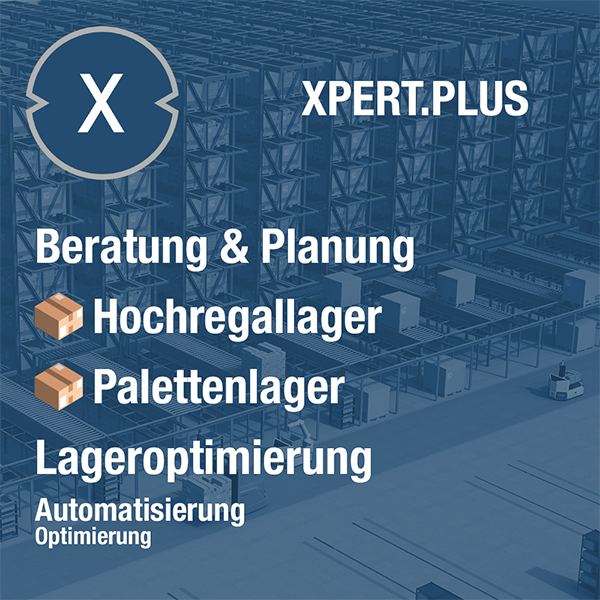
Xpert.Plus warehouse optimization - high-bay warehouses such as pallet warehouses consulting and planning
We are there for you - advice - planning - implementation - project management
☑️ SME support in strategy, consulting, planning and implementation
☑️ Creation or realignment of the digital strategy and digitalization
☑️ Expansion and optimization of international sales processes
☑️ Global & Digital B2B trading platforms
☑️ Pioneer Business Development
I would be happy to serve as your personal advisor.
You can contact me by filling out the contact form below or simply call me on +49 89 89 674 804 (Munich) .
I'm looking forward to our joint project.
Xpert.Digital - Konrad Wolfenstein
Xpert.Digital is a hub for industry with a focus on digitalization, mechanical engineering, logistics/intralogistics and photovoltaics.
With our 360° business development solution, we support well-known companies from new business to after sales.
Market intelligence, smarketing, marketing automation, content development, PR, mail campaigns, personalized social media and lead nurturing are part of our digital tools.
You can find out more at: www.xpert.digital - www.xpert.solar - www.xpert.plus




